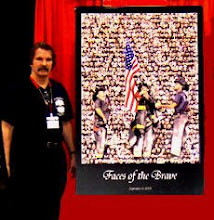9/11 Memorial to be Installed Outside Engine 10/Ladder 10 Across from Ground Zero
NEW YORK – April 27, 2006
On September 11, 2001 when two hijacked airplanes were deliberately flown into the Twin Towers of the World Trade Center, Holland & Knight’s New York partner, volunteer firefighter and EMT Glenn J. Winuk ran out of his office at 195 Broadway, across the street from the World Trade Center site, and toward the burning buildings to help. Like so many others, Glenn died that morning, in an act that could only be described as truly heroic.
Inspired by those events, lawyers and staff throughout Holland & Knight's offices nationwide began a grassroots campaign to build a tribute dedicated to Glenn and the 343 members of the New York City Fire Department who perished that day.
The campaign, which was coordinated through the Holland & Knight Charitable Foundation, will culminate in just a few weeks, with the completion of an extraordinary 9/11 memorial – a bas-relief sculpture, 56 feet long and six feet high, made of solid bronze, depicting FDNY members responding to the scene on September 11th. The 9/11 memorial – believed to be the largest bas-relief sculpture in North America – will be presented by Holland & Knight as a gift to the New York City Fire Department at a dedication ceremony on June 10, 2006.
An inscription on the sculpture’s upper portion reads, “Dedicated to those who fell and to those who carry on – May we never forget.” “It was very important for the lawyers and staff at Holland & Knight to forever memorialize our beloved friend and partner, Glenn Winuk, as well as the Fire Department members who died that tragic day,” said Brian D. Starer, a partner in Holland & Knight's New York office and Vice President of the Holland & Knight Charitable Foundation. “We want to present this gift to the Fire Department as a token of our unending gratitude to these men and women, and their families, for the sacrifices they made that day.”
The 9/11 memorial will be installed at the quarters of Engine10/Ladder10, which is directly across the street from Ground Zero and just two blocks from Holland & Knight's office. A listing of active Fire Department members lost that day will be displayed on the sculpture by rank (in alphabetical order) and include each member’s company number. A timeline of major milestone events surrounding the September 11th attack and the Department’s rescue and recovery effort will also be incorporated into the base of the rendering.
“We are deeply grateful to Holland & Knight for this extraordinary gift that will be on permanent display outside Engine 10/ Ladder 10 for all to see and remember the events of that tragic day,” said Fire Commissioner Nicholas Scoppetta. “We are profoundly touched that so many of the firm's lawyers and staff chose this very personal way to remember not only their colleague Glenn Winuk, and the brave members of this Department who died on September 11th, but also those who continue to protect the citizens of New York City everyday. We are truly honored.”
The 9/11 memorial was designed by the Rambusch Company, a New Jersey firm of artisans which opened in 1898 and specializes in ecumenical metal work, stained glass and lighting. Scenes depicted in the sculpture will honor FDNY members who responded to the World Trade Center site and those who continued to work on-site until recovery operations were completed. The 9/11 memorial will be dedicated in a special joint Fire Department/ Holland & Knight ceremony on Saturday June 10, 2006, to pay tribute to the heroes of the FDNY and Glenn Winuk. That day was selected because it is the fourth anniversary of the conclusion of Fire Department recovery operations at Ground Zero.
About Holland & Knight LLP and Holland & Knight Charitable Foundation, Inc.
Holland & Knight LLP is a global law firm with more than 1,150 lawyers in 17 U.S. offices. Other offices around the world are located in Mexico City, Tokyo and Beijing, with representative offices in Caracas, Helsinki and Tel Aviv. Holland & Knight is among the world’s 15 largest firms, providing representation in litigation, business, real estate and governmental law. Our interdisciplinary practice groups and industry-based teams ensure clients have access to attorneys with the best expertise, regardless of location.
The Holland & Knight Charitable Foundation, Inc. was created in 1996 to take over the management and coordination of the law firm's ever-increasing charitable contributions and activities. The Foundation is funded through contributions from the firm, its lawyers, and staff and external contributions and grants. The Foundation, a Section 501(c)(3) public charity, is run by partners of the law firm and a professional staff.

